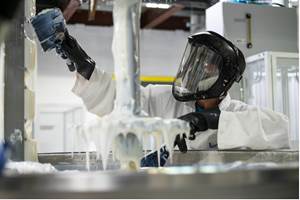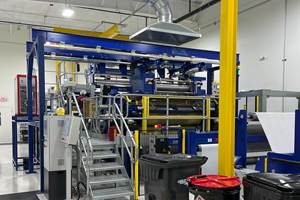Automotive tipping point?
CW Editor Jeff Sloan predicts a tipping point for autocomposites after attending this year’s Society of Plastics Engineers’ Automotive Composites Conference and Exhibition (SPE ACCE).
It’s early September as I write this and I am at the Society of Plastics Engineers’ Automotive Composites Conference and Exhibition (SPE ACCE) in the Detroit suburb of Novi, MI, US. If you are involved in autocomposites manufacturing, this is a must-attend event, drawing material and equipment suppliers, designers, fabricators, tier suppliers and OEMs from throughout the global automotive supply chain.
I have attended SPE ACCE almost every year since I became editor of CW in 2006. I have seen it weather seriously lean times during the 2009-2011 Great Recession, and I have seen it thrive since. I have listened each year to presentations about resins, fibers, manufacturing processes and software solutions aimed at making composites viable for high-volume automotive manufacturing. I have also heard automotive OEMs declaim what we’ve all heard are the serious disadvantages of composites: they are too expensive, too slow, too difficult to design, too difficult to model, too different.
For many years, it seemed composites might be perpetually relegated to high-end, high-priced, low-volume vehicles, destined to be purchased by the relatively few owners who could afford these “exotic materials.” The composites industry, of course, was not blind or deaf to the criticism leveled at it by automotive OEMs. In response, material and equipment suppliers and fabricators have worked diligently to develop technologies that reduce cost and cycle time. Advanced CAD and CAE programs, snap-cure resins, multimaterial adhesives, low-density SMC, and many other innovations leap to mind.
As a result, three or four years ago, we started seeing evidence of composites migrating into mid-priced, mid-volume vehicles from automakers like BMW and Audi. High-volume vehicles? Gosh, we were told, those same hurdles still loomed — price, cycle time, design inefficiency.
This year, walking the exhibit floor, listening to keynote speakers and taking in technical presentations, I have seen some remarkable things. Take, for instance, this morning’s keynote speaker, Mark Voss, engineering group manager at General Motors Co. He described in great detail the six-year development of the carbon fiber/nylon SMC pickup truck bed for the 2019 GMC Sierra Denali. He described the persistent, creative effort GM and its partners put into development of this first-of-its-kind, highly durable, versatile, tough bed that weighs 62 lb less than its steel predecessor.
Or, consider the Ford Motor Co. front-end module demonstrator on display in the Ashland booth. Covered in the August 2018 issue of CW, this structure, made by Magna International in cooperation with Ford, was fabricated with co-molded NCF and SMC, and consolidated 45 parts in the 27.4-kg steel version to just six parts in the composite version. It also reduced weight 34% and, over its life, is a more cost-effective, sustainable alternative. The truth is that you can’t walk more than a few feet at this conference and not discover a composite part or structure that proves not just the viability of composites in high-volume automotive, but their sensibility and affordability.
Frankly, any automotive OEM looking to reduce vehicle weight by converting major structures to composites has no shortage of options to do that efficiently. There are just too many fiber, resin and equipment options available to claim that it’s not possible. On top of that, the composites industry is replete with subject matter experts who have demonstrated repeatedly that they are more than willing and able to help automakers apply composites successfully. Of course, this is a not a one-way street: The willingness composites professionals possess must be matched by the willingness of carmakers.
This said, I do not mean to imply that all of the woes of autocomposites have been banished. Challenges remain, but if there is an autocomposites tipping point, this might be it.
Yes, composites are complex and atypical and occasionally confounding, and they are not the best material for all vehicle applications. But they are a great option for many vehicle applications, and they are easier to apply today than ever before.
Am I right? Time will tell, and in the meantime, we will continue to help make sure you are up to speed on the always-interesting autocomposites journey.
Related Content
Scott Bader ATC begins Crestabond MMA structural adhesive production
Scott Bader’s Drummondville, Canada, facility has begun manufacturing and supplying composites-applicable adhesives to its North American customers.
Read MoreComposite resins price change report
CW’s running summary of resin price change announcements from major material suppliers that serve the composites manufacturing industry.
Read MoreEpoxy-based structural film adhesive intended for aerospace, MRO
CAMX 2023: Park Aerospace is presenting its new aerospace-grade film adhesive material Aeroadhere FAE-350-1, in addition to other product offerings intended for aerospace, defense and spacecraft.
Read MoreHenkel receives Airbus qualification for European aerospace manufacturing facility
The adhesive company’s Montornès, Spain, plant has been approved as a standard and raw materials supplier for various Airbus platforms, adding to its work in lightweighting, fuel efficiency and automation.
Read MoreRead Next
From the CW Archives: The tale of the thermoplastic cryotank
In 2006, guest columnist Bob Hartunian related the story of his efforts two decades prior, while at McDonnell Douglas, to develop a thermoplastic composite crytank for hydrogen storage. He learned a lot of lessons.
Read MoreComposites end markets: Energy (2024)
Composites are used widely in oil/gas, wind and other renewable energy applications. Despite market challenges, growth potential and innovation for composites continue.
Read MoreCW’s 2024 Top Shops survey offers new approach to benchmarking
Respondents that complete the survey by April 30, 2024, have the chance to be recognized as an honoree.
Read More


























